



In the last few years, India-U.S. bilateral relations have developed into a "global strategic partnership", based on shared democratic values and increasing convergence of interests on bilateral, regional and global issues.
The two countries have created a lot of opportunities to reinvigorate bilateral ties and enhanced cooperation under the motto --- “Chalein Saath Saath: Forward Together We Go”.
Regular exchange of high-level political visits has provided sustained momentum to bilateral cooperation. Also, the ever-expanding dialogue architecture has established a long-term framework for India-U.S. engagement.
But what have been the various phases of the relationship between these two countries? How far have we come in terms of our bilateral strategic cooperation? What have been the sticking points? What is the future of Indo-US relationship in this changing strategic landscape?
In order to get answers of all these questions we need to travel back in time.

The relationships between India in the days of the British Raj and the United States were thin.
Swami Vivekananda promoted Yoga and Vedanta in the United States at the World's Parliament of Religions in Chicago, during the World's Fair in 1893.
Mark Twain visited India in 1896 and described his experience in his travelogue “Following the Equator”. He expressed both revulsion and attraction but he concluded that India was the only foreign land he dreamed about or longed to see again.
Mahatma Gandhi had an important influence on the philosophy of non-violence promoted by American civil rights movement leader Martin Luther King Jr. in the 1950s.
In the 1930s and early-1940s, American Prime Minister Roosevelt voiced strong support to the Indian independence movement despite being allies with Britain.
Everything changed during World War II, when India became the main base for the American-China-Burma-India Theater (CBI) in the war against Japan. Tens of thousands of American servicemen arrived, bringing all sorts of advanced technology, and money. They left in 1945.
Serious tension erupted when America under US President Franklin D. Roosevelt, demanded that India should be given independence, a proposition which Winston Churchill (the then British PM) vehemently rejected.
For years, Roosevelt had encouraged British disengagement from India.
The American position was based on
The United States under the Truman administration leaned towards favoring India in the late-1940s since U.S. saw India more valuable diplomatically than neighboring Pakistan.
|
The Cold War The Cold War was a period of geopolitical tension between the Soviet Union and the United States and their respective allies, after World War II. The period is generally considered to span the 1947 Truman Doctrine to the 1991 dissolution of the Soviet Union. The term "cold" is used because there was no large-scale fighting directly between the two superpowers. However, they supported major regional conflicts known as proxy wars. The conflict was based around the ideological and geopolitical struggle for global influence by the two powers. The West was led by the United States as well as the other First World nations of the Western Bloc and the East was led by the Soviet Union and its Communist Party, which had an influence across the Second World. The US government supported right-wing governments and uprisings across the world, while the Soviet government funded communist parties and revolutions around the world. As nearly all the colonial states achieved independence in the period 1945–1960, they became Third World battlefields in the Cold War. |
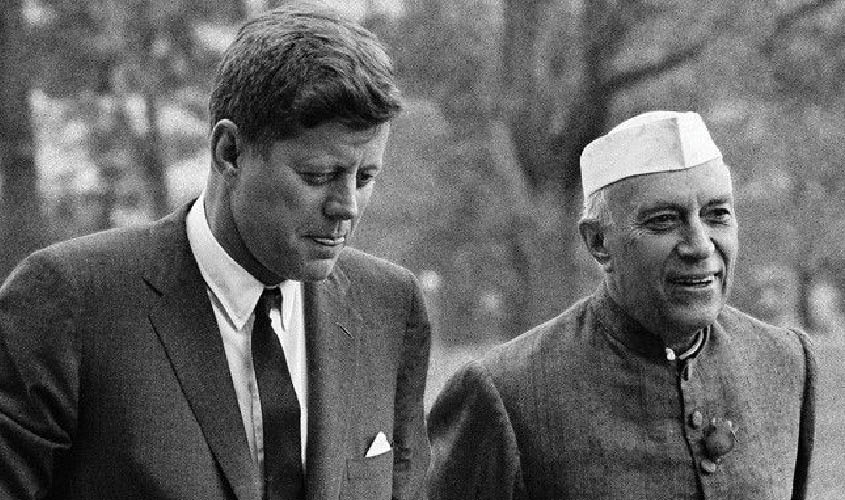
Post Independence Indo-US relations were overshadowed by Cold War politics. The Indo-Soviet friendship and the US-Pak alliance were the two major irritants.
During the Cold War, India’s policy of non-alignment was perceived negatively by the US officials.
Thus, although ‘aid relations’ prevailed during 1950s and 1960s, New Delhi and Washington saw each other on opposite sides of the fence during this period.
However, Presidents Kennedy and Lyndon Johnson were in favor of maintaining good relations with India.
The Kennedy administration openly supported India during the 1962 Sino-Indian war and considered the Chinese action as "blatant Chinese Communist aggression against India".
The United States Air Force flew in arms, ammunition and clothing supplies to the Indian troops along with aircraft carrier to protect India.
But following the assassination of Kennedy in 1963, Indo-US relations deteriorated gradually. The 1965 Indo-Pak War undid everything. Washington lost interest in the region. The Afghan war witnessed US political support tilting again towards Pakistan.
Later, in the mid-1980s the US strategy was to wean India away from the Soviet Union.
Dramatic turn occurred in the 1990s when the Cold War was terminated with the disintegration of the Soviet Union. US-Pakistan relations plunged, due to Pakistan’s secret nuclear programme. In the 1990s, Indian foreign policy also developed closer ties with the United States.
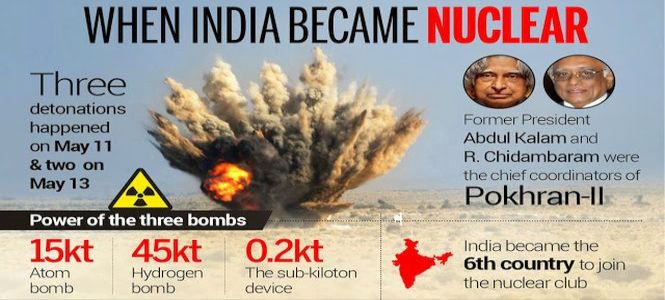
The United States strongly condemned Pokhran Nuclear Test. It voted in favour of a United Nations Security Council Resolution condemning the tests. President Bill Clinton imposed economic sanctions on India, including cutting off all military and economic aid, freezing loans to the Indian government except food purchases, prohibiting American aerospace technology and uranium exports to India etc.
However, these sanctions proved ineffective. India was experiencing a strong economic rise, and its trade with the US only constituted a small portion of its GDP. Only Japan joined the US in imposing direct sanctions, while most other nations continued to trade with India. The sanctions were soon lifted. Afterward, the Clinton administration and Prime Minister Vajpayee exchanged representatives to help rebuild relations.

In the 21st century, India emerged as an increasingly vital country to US foreign policy interests. India, in today’s times is a dominant actor in its region. The home of more than one billion citizens and is now characterized as a nascent Great Power and an "indispensable partner" of the US. It is a potential counterweight to the growing clout of China.
In March 2000, when U.S. President Bill Clinton visited India, the Indo-US Science & Technology Forum was established.
Over the course of improved diplomatic relations with the US under Bush Administration, India agreed to allow close international monitoring of its nuclear weapons development, although it refused to give up its current nuclear arsenal.
After the September 11 attacks against the US in 2001, USA collaborated closely with India in controlling and policing the strategically critical Indian Ocean sea lanes from the Suez Canal to Singapore.
Since 2004, Washington and New Delhi have been pursuing a "strategic partnership" that is based on shared values and generally convergent geopolitical interests. Numerous economic, security, and global initiatives have been collaborated upon.
The U.S.-India partnership is founded on a shared commitment to freedom, democratic principles, equal treatment of all citizens, human rights, and the rule of law. The United States and India have shared interests in promoting global security, stability, and economic prosperity through trade, investment, and connectivity.
The United States supports India’s emergence as a leading global power and vital partner in efforts to ensure that the Indo-Pacific is a region of peace, stability, and growing prosperity. The strong people-to-people ties between our countries are a tremendous source of strength for the partnership. The two countries recently elevated their relationship to Comprehensive Global Strategic Partnership.
The US is India's second largest trading partner, and India is its 9th largest trading partner. Major items imported from India include information technology services, textiles, machinery, gems and diamonds, chemicals, iron and steel products, coffee, tea, and other edible food products.
Major American items imported by India include aircraft, fertilisers, computer hardware, scrap metal, and medical equipment. The United States is also India's largest investment partner, with a direct investment of $10 billion.
From 1999 to 2019, trade in goods and services between the two countries surged from $16 billion to $149 billion. U.S. energy exports are an important area of growth in the trade relationship.
India became the third Asian nation to be granted Strategic Trade Authorization-1 (STA-1) status by the United States. STA-1 enables the export of high-technology products in civil space and defence from the US to India.
India and the United States cooperate closely at multilateral organizations, including the United Nations, G-20, Association of Southeast Asian Nations (ASEAN) Regional Forum, International Monetary Fund, World Bank, and World Trade Organization.
The United States welcomes India joining the UN Security Council in 2021 for a two-year term. It also supports a reformed UN Security Council that includes India as a permanent member. India is an Organization for Economic Cooperation and Development (OECD) partner, and an observer to the Organization of American States.
India is also a member of the Indian Ocean Rim Association (IORA), at which the United States is a dialogue partner. In 2019, the United States joined India’s Coalition for Disaster Resilient Infrastructure to expand cooperation on sustainable infrastructure in the Indo-Pacific region.
Defence relationship has emerged as a major pillar of India-U.S. strategic partnership with the signing of ‘New Framework for India-U.S. Defense Relations’ in 2005. As a result there has been intensification in defence trade, joint exercises, personnel exchanges, collaboration and cooperation in maritime security and counter-piracy. The Defence Framework Agreement was updated and renewed for another 10 years in June 2015.
The two countries now conduct more bilateral exercises with each other than they do with any other country.
Since 2014, the United States and India have signed several agreements that underscored the growing alignment on shared strategic interests. These included two kinds of agreements. The first were broad statements articulating the shared values, principles, and interests of both countries. The second type of agreement is called "foundational" or "enabling" agreement. It is meant to advance interoperability between the US and Indian militaries.
Together, these agreements established the foundation for deeper collaboration on security and strategic issues.
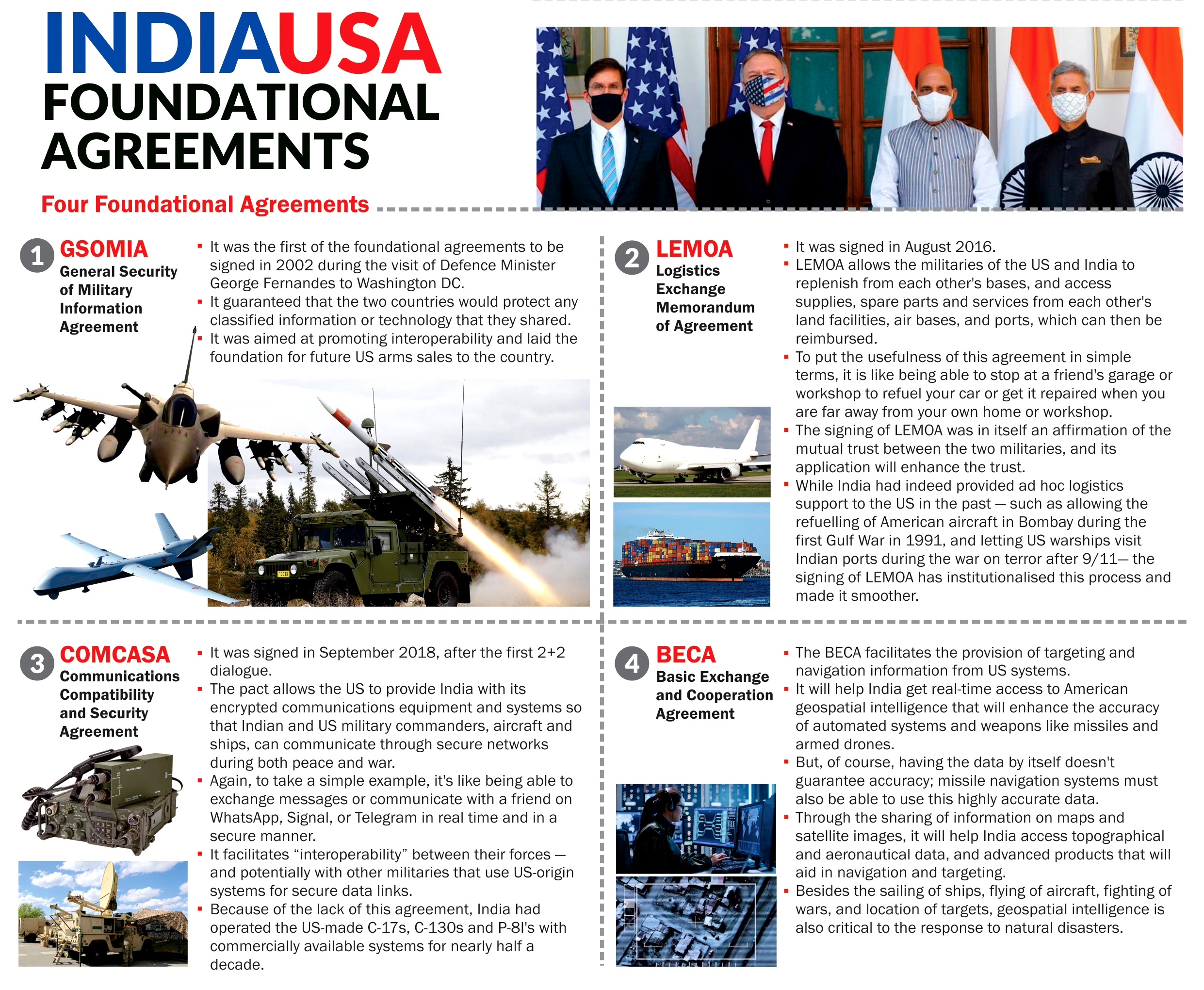
Cooperation in counter-terrorism has seen considerable progress with intelligence sharing, information exchange, operational cooperation, counter-terrorism technology and equipment.
Both sides have called for strict action against all terrorist groups, including the Al-Qaeda, ISIS, Jaish-e-Mohammad, Lashkar-e-Taiba, Hizbul Mujahideen, the Haqqani Network, Tehreek-e-Taliban Pakistan, D-Company, and all their affiliates.
Last year, both United Nations and the United States, designated Mumbai attack mastermind Hafiz Saeed as global terrorist.

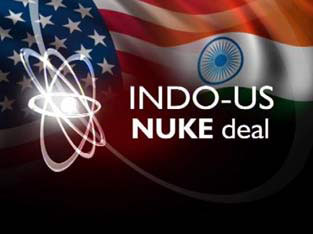
The U.S.–India Civil Nuclear Agreement was signed in 2005, under which India agreed to separate its civil and military nuclear facilities and to place all its civil nuclear facilities under International Atomic Energy Agency (IAEA) safeguards. In exchange, the United States agreed to work toward full civil nuclear cooperation with India.
The two sides have started the preparatory work on site in India for six AP 1000 reactors to be built by Westinghouse. Once completed, the project in Kovvada would be among the largest of its kind.
|
The Westinghouse AP1000 pressurized water reactor (PWR) is the most advanced commercially available nuclear power plant. |
The United States and India have a long and successful strategic partnership in the energy sector. The energy cooperation between the two countries, which is technical, economic, and bilateral, is strengthening year after year.
In 2018, the Government of India elevated the India-US Energy Dialogue to a Strategic Energy Partnership (SEP). SEP has four primary pillars of cooperation -- oil and gas, power and energy efficiency, renewable energy, and sustainable growth.
India is now the fourth largest international market for the US crude oil and the fifth largest for the US liquefied natural gas. Indian firms have concluded several contracts for sourcing crude from the United States and are expanding their investments in the US energy sector, creating jobs and economic opportunities.
Investment by Indian companies like Reliance, Essar and GAIL in the U.S. natural gas market is ushering in a new era of India-U.S. energy partnership. The U.S. Department of Energy also gave its approval for export of LNG from its liquefaction terminals in the U.S., to India.
Recently, an MoU on “Strategic Petroleum Reserves operation” has been signed according to which India would be able to store oil in the U.S. Strategic Petroleum Reserve in the future.
Also, there has been an increase in the bilateral hydrocarbon trade through SEP. (9.2 billion USD during 2019-20-- 93% increase since 2017-18)
In November 2009, the United States and India launched the “Partnership to Advance Clean Energy” (PACE), which is working to accelerate inclusive, low carbon growth by supporting research and deployment of clean energy technologies.
Also, USA’s recent Prioritising Clean Energy and Climate Cooperation with India Act seeks to establish the US-India Clean Energy and Power Transmission Partnership (CEPTP) as the main forum for cooperation between the two nations on clean energy technologies.
The activities under the CEPTP include
The legislation also promotes US-India cooperation on climate resilience and risk reduction.
India and US have also been collaborating on the
The two countries are leading joint research and development (R&D) through Advance Clean Energy-Research (PACE-R) on smart grids and energy storage to increase resilience and reliability of the electric grid.
Recently, India and the US have announced new areas of research on transformational power generation based on supercritical CO2 (sCO2) power cycles and advanced coal technologies, including carbon capture, utilisation, and storage (CCUS).
Efficient Buildings and Clean Technologies
The United States and India have been working to enhance building and appliance efficiency through enhanced building codes, design and operation of smart buildings of the future. This falls under USA’s collaboration with India’s first-ever Solar Decathlon in 2021. It is to establish a collegiate competition to prepare the next generation to design and build high efficiency buildings powered by renewables.
RAISE initiative
It is a national programme to improve indoor air quality. “RAISE” stands for Retrofit of Air-conditioning to improve Indoor Air Quality for Safety and Efficiency”. It is a joint initiative of Energy Efficiency Services Limited (EESL) and the US. Agency for International Development’s (USAID) MAITREE Program. Poor air quality has been a concern in India for quite some time. RAISE initiative envisages alleviating the issue of bad air quality in workspaces across the nation and pioneer ways to make them healthier and greener.
The sides are working to enhance long-term energy development and plans and strategies through adoption of best practices and methodologies in
USAID and NITI Aayog jointly launched the India Energy Modeling Forum. The Energy Modeling Forum is a structured forum for discussing important issues in energy and the environment.
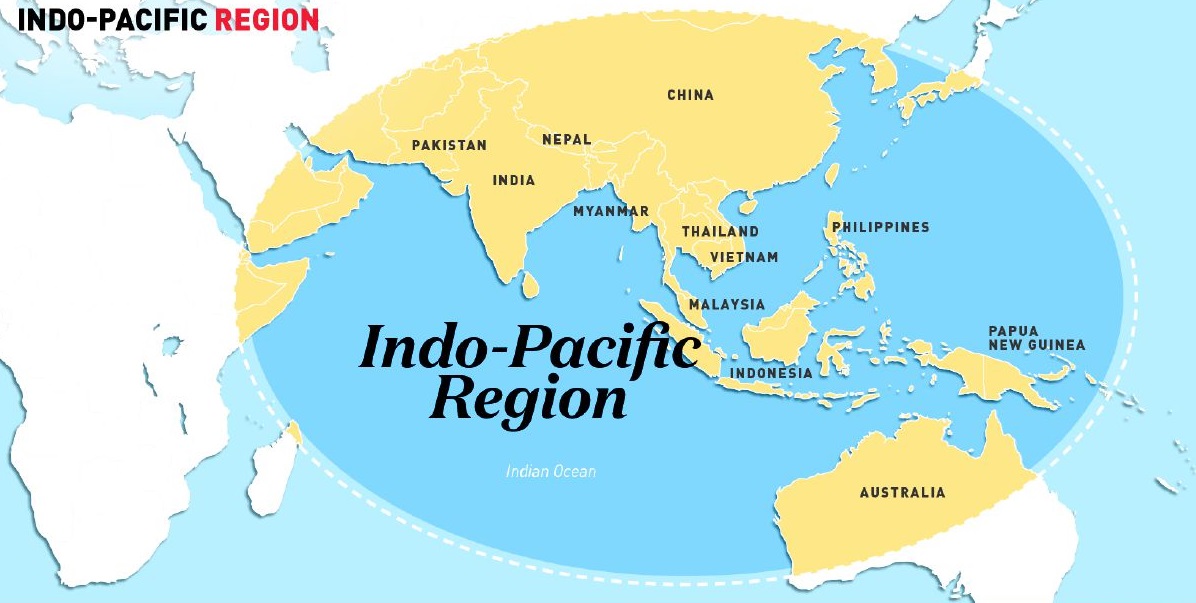
A close partnership between India and the United States is central to a free, open, inclusive, peaceful and prosperous Indo-Pacific region. This cooperation is underpinned by
The United States appreciates India’s role as a net provider of security, as well as developmental and humanitarian assistance in the Indian Ocean Region.
The two countries keep strengthening their relationship through consultations like the India-U.S.-Japan trilateral summits; the 2+2 Ministerial meeting mechanism of the Foreign and Defence Ministers of India and the United States; and the India-U.S.-Australia-Japan Quadrilateral (QUAD) consultations, among others.
Also, India’s role in the Indo-Pacific is considered crucial by the United States as a countermeasure to the growing clout of China in the Indo-Pacific region.
1.jpg)
The India-U.S. S&T cooperation has been steadily growing under the framework of U.S.-India Science and Technology Cooperation Agreement signed in October 2005. There is an Indo-U.S. Science & Technology Joint Commission, co-chaired by the Science Advisor to U.S. President and Indian Minister of S&T.
In 2000, both the governments endowed the India-U.S. Science & Technology Forum (IUSSTF) to facilitate mutually beneficial bilateral cooperation in science, engineering, and health.
Over the past decade, the IUSSTF has facilitated thousands of interactions between Indian and U.S. scientists, bilateral workshops and established over 30 joint research centers.
The U.S.-India Science & Technology Endowment Fund, established in 2009, under the Science and Technology Endowment Board promote commercialization of jointly developed innovative technologies with the potential for positive societal impact.
Collaboration between the Ministry of Earth Sciences and U.S. National Oceanographic and Atmospheric Administration has been strengthened significantly.
India's contribution of $250 million towards Thirty-Meter Telescope Project in Hawaii and Indian Initiative in Gravitational Observations (IndiGO) with U.S. LIGO Laboratory are examples of joint collaboration to create world-class research facilities.
|
The Laser Interferometer Gravitational-Wave Observatory (LIGO) is a large-scale physics experiment and observatory to detect cosmic gravitational waves and to develop gravitational-wave observations as an astronomical tool. Two large observatories were built in the United States with the aim of detecting gravitational waves by laser interferometry. Gravitational waves are 'ripples' in space-time caused by some of the most violent and energetic processes in the Universe. Albert Einstein predicted the existence of gravitational waves in 1916 in his general theory of relativity. |
Cooperation in education sector has been made an integral part of the strategic partnership between the two countries. The Fulbright program seeks to provide more student and scholar exchange grants. Lakhs of Indian students are pursuing advanced degrees in the US. India is learning from the U.S. experience in community colleges in order to meet our demands for skill-development. It has been agreed to collaborate with U.S. institutions in the area of Technology Enabled Learning and Massive Open On-line Courses (MOOCs) to extend the reach of education in India.
Similarly, the Partnership 2020: Leveraging US-India Cooperation in Higher Education to Harness Economic Opportunities and Innovation project is a collaborative agreement between the two countries. The goal of the project is to strengthen the strategic partnership between the United States and India through collaboration in higher education, research on key issue areas, related economic growth, and people-to-people linkages.
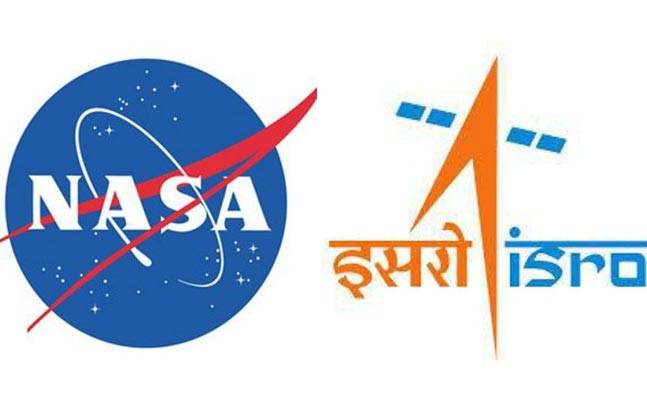
Indo-US space cooperation has a long history. Within four years of establishment of a full-fledged American space programme, in 1962, India became one of the first partners of NASA. During 1975-1976, NASA and ISRO had conducted the Satellite Instrumental Television Experiment, known as SITE. Under this program, NASA's ATS-6 satellite beamed educational programmes via television sets to over two thousand remote Indian villages.
Other areas of collaboration include
In June 2016, ISRO successfully launched record 20 satellites onboard PSLV rocket, which included 13 satellites from the United States.
Today, ISRO and NASA are working towards launching in 2022 a joint mission with the world’s first dual-frequency Synthetic Aperture Radar satellite. The NASA-ISRO SAR (NISAR) Mission will measure Earth’s changing ecosystems, dynamic surfaces, and ice masses providing information about biomass, natural hazards, sea level rise, and groundwater, and will support a host of other applications.
Both agencies are working together in the field of Earth observation, Mars and planetary exploration, helio-physics, human spaceflight, and commercial space cooperation.
The strong people-to-people ties between our countries are a tremendous source of strength for the partnership. The 3-million strong Indian American community is an important ethnic group in the U.S., accounting for about 1% of the total population in the country. The Indian American community enjoys great reputation and significant influence on the American society and polity with its large number of professionals, business entrepreneurs and educationalists marking their positive presence on the national scene. Indian Diaspora has been a catalyst in cementing closer ties between India and the U.S.
Apart from this, in 2019, there were approximately 1.47 million overseas visitors from the India to the United States, making it the tenth highest visiting nation.
Revocation of India’s Special trade status, also known as Generalised System of Preferences by the US is one of the issues. Generalised System of Preferences had allowed India the duty-free imports of goods up to USD 5.6 billion into the US from India. The special status was revoked on the grounds that India had not assured the US that it will provide equitable and reasonable access to its market.
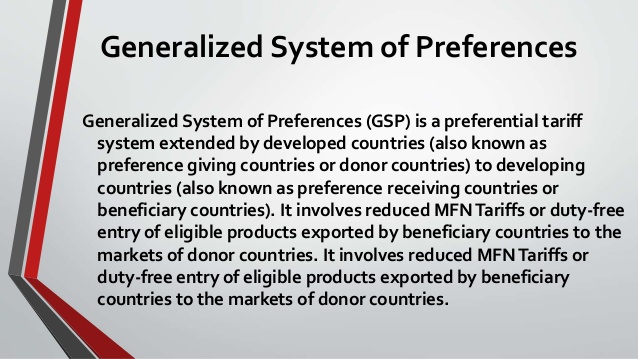
In 2018, the US had imposed tariffs on steel and aluminium imported from India on the grounds of national security under Section 232 of the Trade Expansion Act of 1962. This was followed by a series of protective measures by the US against India.
India responded to these moves by imposing tariffs of USD235 million on the US goods worth USD1.4 billion.
US’ sanctions on Russia through CAATSA – Countering America’s Adversaries through Sanctions Act – are threatening India’s strategic interests. Similarly, US sanctions on Iran and Venezuela are putting India’s energy security at stake.
Example : India’s investments like Chabahar Port in Iran and India’s purchase of S-400 from Russia. India is also concerned over the US’ policy in Afghanistan as it is jeopardizing India’s security and interest in the region.
|
What is CAATSA? The Countering America's Adversaries Through Sanctions Act, (CAATSA) is a United States federal law that imposed sanctions on Iran, North Korea, and Russia. Although the sanctions are not directly imposed on India, it affects India nevertheless. If India does not remove ties with Russia and Iran, the US may invoke sanctions against India. |
India enjoys a trade surplus with US. The trade gap between the countries has increased to USD 17.42 billion in 2019-20 from USD 16.86 billion in 2018-19. It is one of the concerns of US officials.
Recently, the US placed India on its ‘Priority Watch List’ among other countries over the issue of Intellectual Property Rights (IPR). India has been alleged for not taking sufficient measures to improve its IP framework which has negatively affected the US right holders in the past years.

According to the US, weak IP regime in India makes it tough for innovators to receive and maintain patents in India, especially pharmaceuticals. Insufficient enforcement actions, copyright policies that do not properly incentivize the creation, commercialization of content, and an outdated and insufficient trade secrets legal framework are some of the issues mentioned by plan report of Office of the United States Trade Representative (USTR).
Donald Trump’s “America first policy” followed by ban on temporary H1-B visas in efforts to cut down outside workforce has been a major impediment as it could affect hundreds of Indians.
Most of our differences are due to US’ aggression toward third countries. Barring a few challenges, a fundamental understanding and mutual trust has strengthened the value of relationship between the bureaucracies and policy communities in both countries.
Today, the US is among India’s most important security partners and the most comprehensive, with collaboration extending to intelligence, homeland security, defence technology, and maritime, space, and cyber cooperation.
US is also perhaps India’s most comprehensive economic partner, if research and development (R&D), education, technology, employment, energy, and health care are taken into consideration.
For the US, the India partnership has progressed at a time when almost every other major relationship — with both adversaries and allies — has experienced immense tumult.
The US, for its part, however should be cautious on two fronts: Military supplies to Pakistan and Kashmir issue. The US will run into problems if it gets involved in the Kashmir issue. Also, military supplies to Pakistan could lead to deterioration of relationship between India and US.
Apart from this, the future is full of optimism. There is a common focus on combating terrorism, especially cyber terrorism. There are no major strategic issues dividing the two countries; above all, there is a strong desire to move ahead in improving bilateral relations. Cooperation in the non-military nuclear energy sphere is another Greenfield area.
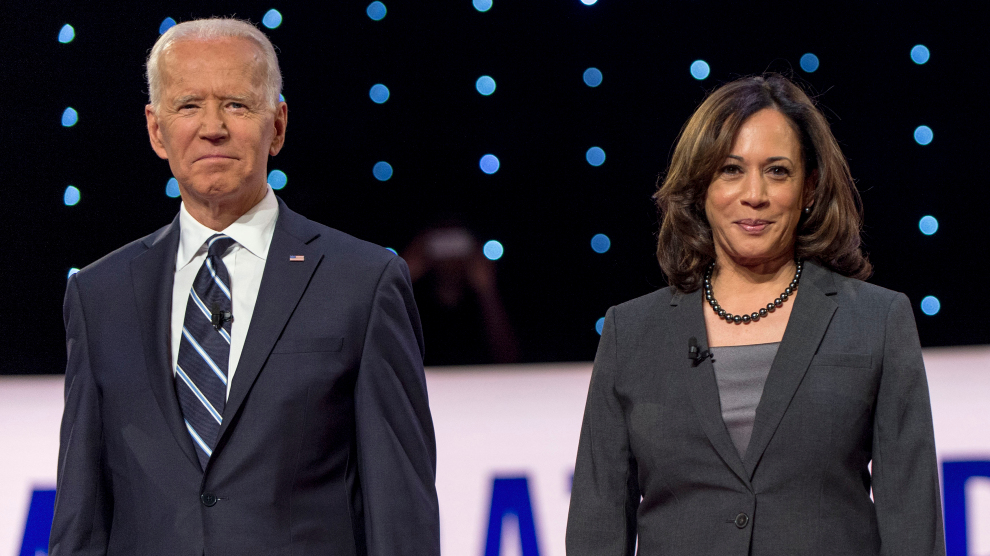
President Donald Trump has been a friend of India for four years. Yet, he had India on tenterhooks too with his non-traditional leadership. For example: Protectionism under his “America First Policy”.
Joe Biden’s president-ship could lead to restoration of traditional American leadership backed by promotion of democracy, stability, human rights, cultural and religious freedoms, plurality and inclusiveness. The administration’s mature handling without unnecessary bias towards ‘America First’ in this domain could set the course for an even more transformational relationship between India and USA based upon cooperation and collaboration.
Considering geopolitical challenges to their strategic interests in the region, both India and the US should focus on areas of strategic convergence.
From India, a bit of marketing, a bit of positioning, and a lot of strategic thinking is required. A way out could be to move forward on further strengthening the strategic aspect of relations where there is greater harmony.
The two countries should move beyond trade issues with a microscopic focus on agriculture, dairy and poultry. They should build upon mutual strengths in other economic domains for a reliable and substantial partnership. The need of the hour is to look at the big picture.
© 2025 iasgyan. All right reserved